Exploring Large Wave Photography: Aesthetic and Ethics
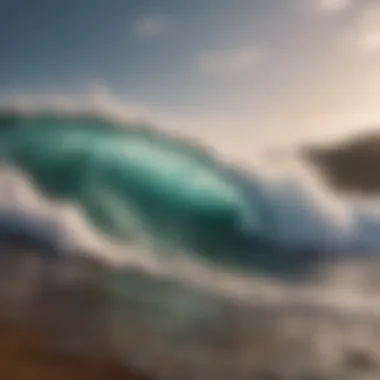
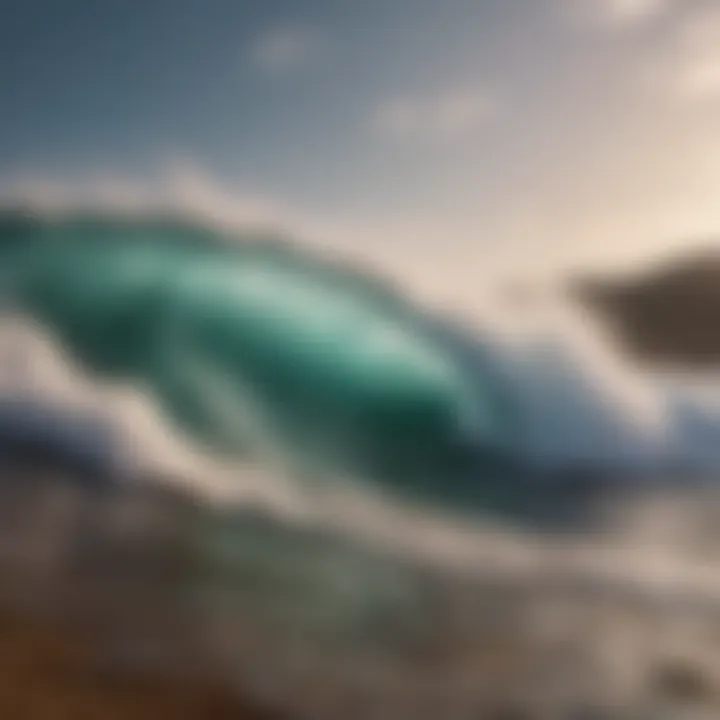
Intro
Large wave photography stands at a unique intersection of art and sport. Photographers are drawn to the challenge of capturing the ocean's might and allure. The images they create tell stories of power, beauty, and the inherent risks associated with this discipline.
Understanding the nuances of this field requires an appreciation of the technical requirements, environmental issues, and the personal experiences of those who venture to the world's most formidable surf spots.
Extreme Sports Overview
Definition of Extreme Sports
Extreme sports encompass activities that involve a high degree of danger and adrenaline. Examples include surfing, snowboarding, and rock climbing. Large wave surfing, as an extreme sport, requires not only skill but also insight into unpredictable conditions.
History and Evolution
The culture of extreme sports has evolved over decades. Surfing, in particular, has roots dating back to ancient Polynesia, but large wave surfing took shape in the 20th century as technology and commitment levels increased. Early pioneers like Greg Noll and even today’s big wave surfers such as Laird Hamilton have shaped the landscape of this sport.
Popular Extreme Sports Disciplines
Among the various extreme sports, large wave surfing holds a distinct position. Other notable disciplines such as skydiving and BASE jumping share a similar ethos of pushing personal limits. Large wave surfing, however, focuses on mastering the ocean's unpredictable nature.
Gear and Equipment
Essential Gear for Different Sports
Capturing the essence of large waves requires specialized equipment. A high-quality DSLR or mirrorless camera with a fast shutter speed is essential. Lenses such as the Canon EF 70-200mm f/2.8 or the Nikon Z 24-70mm f/2.8 are favored for their versatility.
Gear Reviews and Comparisons
Many photographers rely on waterproof housings like the SPL Water Housing or AquaTech, which ensure protection from saltwater elements. Additionally, tripods suitable for sandy and rough environments, such as those made by Gitzo or Manfrotto, are crucial for stability.
Safety Ratings and Certifications
Safety is paramount when photographing extreme sports. Equipment should meet relevant safety standards, and all photographers should assess their own capabilities before attempting to shoot in hazardous environments.
Training and Preparation
Physical Conditioning and Fitness Tips
Just like athletes, photographers must maintain a level of physical fitness. Engaging in cardiovascular workouts and flexibility training can prepare one for the physical demands placed by navigating rugged shores and strong currents.
Mental Preparation Techniques
The volatile nature of large waves can lead to high stress. It is vital to practice mindfulness and visualizations to remain focused during shoots. Techniques like controlled breathing can help reduce anxiety in high-pressure situations.
Training Regimens for Various Sports
For those interested in practical experience, joining workshops or training programs can enhance skills. Many veteran photographers offer insights into their process, helping newcomers grasp both the art and sport aspects.
Locations and Destinations
Top Destinations for Extreme Sports
Iconic locations for large wave photography include Banzai Pipeline in Hawaii, Teahupoʻo in Tahiti, and Mavericks in California. Each location presents unique challenges and breathtaking photo opportunities.
Travel Tips and Guides
Traveling to these destinations requires significant planning. Weather conditions, travel restrictions, and local regulations should be researched thoroughly before embarking on a journey. Engaging with local surf communities can provide valuable insider information.
"The ocean stirs the heart, inspires the imagination and brings eternal joy to the soul." - Wyland
The world of large wave photography is not just about the images captured; it is a combination of respect for the environment and an appreciation for the skill involved. Future articles will delve into these themes further.
Prolusion to Large Wave Photography
Large wave photography stands at the intersection of artistry and adventure. It captures the soul of the ocean’s most dynamic moments, pulling us into its grandeur and ferocity. Understanding this art form is essential for photographers and enthusiasts alike. It not only embraces technical skills but also highlights the emotional connection between man and nature.
Overview of the Art Form
Large wave photography is a specialized genre focusing on the majestic and sometimes ferocious beauty of ocean waves. This art form transcends mere image capturing; it captures emotion, movement, and the raw power of nature. Photographers venture into precarious settings, often amidst turbulent waters, to convey the dramatic and ephemeral nature of waves. They use various techniques to showcase these fleeting moments, creating breathtaking images that evoke a sense of awe.
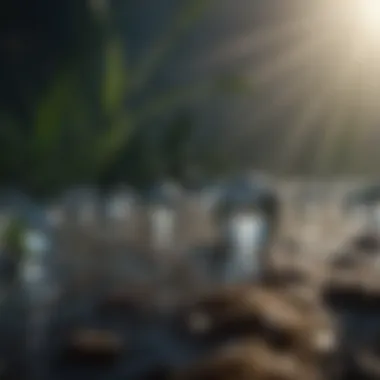

Key elements include:
- Timing and Patience: Photographers must wait for the right moment when the wave crests beautifully.
- Technical Mastery: Understanding exposure, shutter speed, and other settings is critical to achieve the desired visual effect.
- Creative Vision: Beyond technical skills, a keen eye for composition and light plays a significant role in creating striking images.
The Intersection of Nature and Photography
Large wave photography uniquely illustrates the relationship between humanity and the natural world. It emphasizes the beauty and tumult of the ocean. Waves can be calming or chaotic, reflecting different moods and stories. Photographers capture these moments, allowing viewers to experience the energy and tranquility of the sea without being physically present.
This art form can spark conversations about ocean conservation and the environment. As photographers immortalize these magnificent displays of nature, they also highlight the necessity of preserving such beauty for future generations. Through their lenses, they become advocates for an environment in need of stewardship.
In summary, both the craft and philosophy of large wave photography open doors to deeper understanding. This genre compels participants to reflect on nature and its power, impacting how viewers perceive and engage with the ocean.
Understanding Wave Dynamics
Understanding wave dynamics is essential for any photographer aspiring to capture the raw power and beauty of large waves. This knowledge provides insights into how waves form, move, and break. It allows photographers to anticipate wave behavior, enabling them to choose the right moment and angle for their shots. Without an understanding of these principles, capturing striking images becomes a matter of chance rather than skill.
Wave dynamics involve various physical factors that influence how waves develop. It is crucial for photographers to grasp these concepts, as they can directly affect both the quality of the photographs and personal safety in extreme conditions.
The Science of Waves
Waves result from the transfer of energy through a medium, typically water in the case of ocean waves. When wind blows across the surface of the ocean, it creates friction, generating energy that travels through the water. The characteristics of waves, such as their speed, height, and frequency, are influenced by several factors:
- Wind Speed: Faster winds generate larger waves. The energy transfer from wind to water increases with wind speed.
- Fetch: Fetch refers to the distance over which the wind blows across open water. A long fetch allows waves to gather more energy, resulting in larger sizes.
- Water Depth: Shallower waters cause waves to slow down and increase in height. This phenomenon is known as wave refraction.
- Tides and Currents: Local tide conditions and underwater currents also play a significant role in shaping wave formations.
Understanding these aspects will allow photographers to evaluate conditions before heading out. They need to assess wind speeds and direction, considering how tides will impact wave behavior.
Factors Affecting Wave Size
Various elements contribute to the size of ocean waves, and recognizing them can enhance a photographer's effectiveness. Significant factors include:
- Seasonal Variations: Different seasons exhibit varied wave patterns due to changes in wind patterns and storm activity.
- Storm Systems: Storms, especially hurricanes, can generate massive waves thousands of miles away from the storm center, creating ideal conditions for huge waves in coastal areas.
- Local Geography: The physical layout of the coastline can affect wave size. For example, underwater features like canyons can amplify wave heights.
- Weather Conditions: Local weather can alter wave intensity. Barometric pressure fluctuations can impact conditions leading to storm formation.
Photographers must analyze these factors to select prime locations and times for shooting. The interplay between these dynamics and the art of photography creates a challenging yet rewarding pursuit for those drawn to large wave photography.
Essential Equipment for Capturing Waves
The realm of large wave photography hinges on the right equipment. Without appropriate tools, capturing the sheer power and beauty of waves becomes an arduous task. Attention to detail in choosing the right camera, lenses, and stabilization tools can be a game-changer in how images turn out. Each component plays a vital role in framing the aesthetic experience while accommodating environmental challenges.
Camera Types and Lenses
Choosing the right camera is fundamental. For large wave photography, many professionals prefer DSLRs or mirrorless cameras due to their versatility. These types of cameras allow for quick changes in settings and excellent low-light performance. A full-frame sensor is advantageous, as it accommodates dynamic range, capturing intricate details in both highlights and shadows.
Lenses are equally critical. Wide-angle lenses, ranging from 14mm to 24mm, are favored for capturing sweeping seascapes, showcasing the enormity of waves against the backdrop of the shoreline. On the other hand, telephoto lenses, such as 70-200mm, allow for detailed close-ups of surf action, creating dramatic images that highlight the texture and motion of the waves. The choice of aperture is vital as well; a wider aperture can blur backgrounds effectively, directing the viewer's gaze to the waves' intricate forms.
When selecting a lens, one should also consider the weatherproofing features. Waves can splash or crash, and having gear that can withstand moisture contributes to the longevity of the equipment.
Stabilization Tools
The act of capturing high-energy waves demands stability. This is where stabilization tools come into play. A tripod is essential for long exposure shots, which can create ethereal effects on the water's surface. A sturdy, but portable tripod is ideal, ensuring that it does not become an obstacle while shooting on rocky or sandy locations.
In addition to tripods, gimbals provide an extra layer of steadiness. For those using drones to capture aerial shots of waves, a gimbal stabilizer is crucial. It minimizes shakes and vibrations, ensuring the footage remains smooth.
Consider also the use of weather-resistant gear. This protection is particularly valuable when engaging in seaside shoots, where unpredictable weather can threaten both safety and equipment integrity.
"The right equipment makes all the difference. Without it, the potential of the waves can go unrealized."
In essence, adequate preparation involves understanding what tools to utilize in various conditions. By renting or investing in the recommended cameras and stabilization tools, photographers can elevate their craft and embrace the dynamic beauty of large wave photography.
Techniques in Large Wave Photography
Capturing the essence of large wave photography requires an understanding of distinct techniques that enhance the visual impact of ocean imagery. Each technique offers unique benefits and considerations that contribute to the overall aesthetic and narrative quality of the photographs. Mastering these techniques allows photographers to convey the power, movement, and beauty of the ocean, making their work more compelling and evocative.
Shutter Speed and Exposure
Shutter speed is crucial in wave photography, as it directly influences how motion is captured in an image. A slow shutter speed can create a smooth blur effect, portraying waves as flowing movements. This approach artfully shows the fluidity of water, giving it a serene appearance. In contrast, fast shutter speeds freeze action, depicting waves with sharp, dramatic details. The choice of shutter speed depends on the desired effect, the light conditions, and the specific moment being captured.
- Fast Shutter Speed: 1/1000 second or faster is ideal for freezing the dynamic motion of crashing waves. This technique captures moments like the splashes of water and the intricate details of each wave, emphasizing the chaos and power of the ocean.
- Slow Shutter Speed: Ranges from 1/30 to several seconds, allows for artistic interpretation of wave movement. The long exposure time can transform waves into ethereal forms, creating a calm and dreamy atmosphere.
The appropriate exposure setting is equally important. A well-exposed image ensures that details are not lost in highlights or shadows. Generally, using a histogram during shooting can help photographers assess exposure levels accurately. Also, filters such as neutral density (ND) filters can be beneficial. ND filters reduce the amount of light entering the camera, enabling photographers to use slower shutter speeds even in bright daylight.
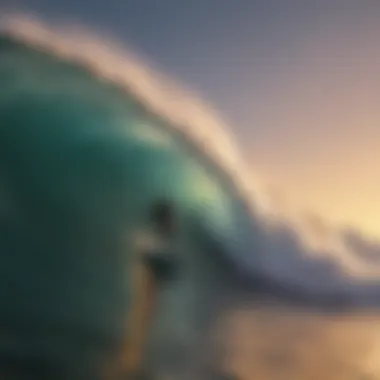
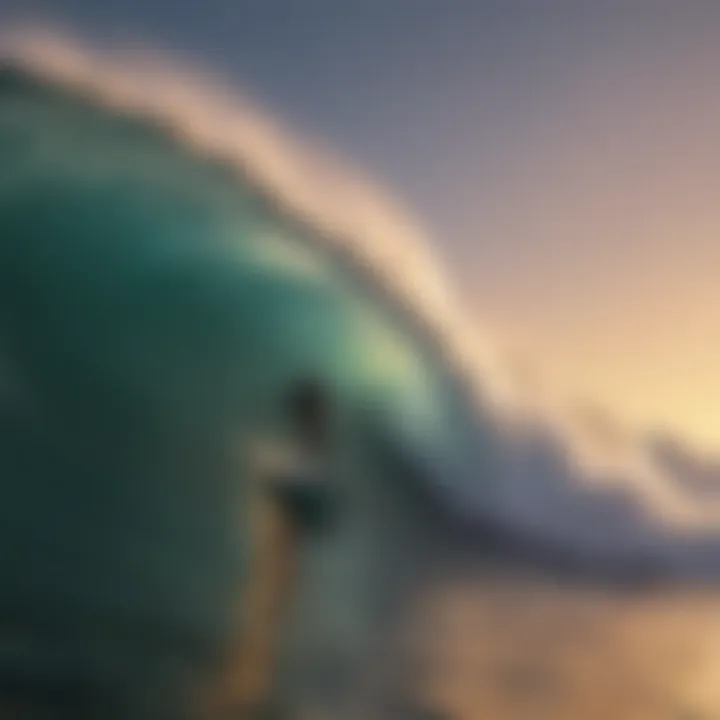
Composition Strategies
Composition in wave photography is paramount. It involves arranging elements in the frame to create a visually pleasing or thought-provoking image. Here are essential composition strategies that can elevate wave photographs:
- Rule of Thirds: Placing the horizon line either in the upper third or lower third of the frame can create dynamic balance and emphasize the waves or sky.
- Leading Lines: Use natural lines like beach edges or wave patterns to draw the viewer's eye into the image. This technique creates a sense of direction and movement, enhancing the overall flow of the photograph.
- Foreground Interest: Including elements in the foreground, such as rocks or seaweed, adds depth and context to the image. This layering leads the viewer's eye and creates a more immersive experience.
- Framing: Using natural frames like overhanging branches or rock formations can focus attention on the waves while adding intrigue to the composition.
Additionally, factors such as light and time of day significantly impact the aesthetic quality of the photographs. Early morning or late afternoon light can provide soft, warm tones that enhance the scene's beauty.
Often, capturing waves is a matter of patience. Observing the ocean's rhythms and understanding when to press the shutter can mean the difference between an ordinary photograph and a breathtaking one.
"The art of photography is about capturing moments that convey feelings and narratives, especially in dynamic environments like the ocean."
In summary, mastering shutter speed, exposure, and composition strategies is essential for successful large wave photography. These elements not only enhance the visual appeal but also help tell the powerful stories of nature's forces.
Challenges in Extreme Photography Conditions
Large wave photography is synonymous with thrill and beauty, yet it does not come without its own set of challenges. Understanding these issues is crucial for capturing compelling images while ensuring personal safety and regard for environmental surroundings. This section will examine the multifaceted aspects of conditions that photographers face when documenting these majestic waves.
Weather and Environmental Factors
Weather poses a significant challenge for photographers working in extreme conditions. The unpredictable nature of storms, tides, and wind can dramatically affect a photo shoot. Here are some key considerations:
- Forecast Knowledge: Monitoring weather patterns is essential. Photographers usually rely on local forecasts, satellite images, and tide tables. Tools like Windy or NOAA’s surf forecasts help in planning shoots effectively.
- Lighting Conditions: The time of day can change how waves look. Early mornings and late afternoons provide softer light. Midday sun tends to create harsh contrasts, which may wash out details.
- Ocean Conditions: Wave behavior is influenced by factors such as wind speed, swell direction, and ocean floor topography. Understanding rip currents and surf zones can prevent dangerous situations.
Capturing waves at the right moment can be fleeting as conditions can evolve rapidly. Often, stormy weather can create dramatic waves, but also danger. Photographers must balance the desire for compelling images with the risks that accompany them.
Personal Safety Considerations
Safety should always be the priority when engaging in large wave photography. The ocean is unpredictable, and waves can pose serious threats to life and limb. Here are essential safety measures:
- Proper Gear: Equip yourself with personal flotation devices and suitable footwear. Wetsuits can offer warmth while also aiding mobility in case of falls.
- Awareness of Surroundings: Keeping an eye on the surf and understanding local geography can mitigate risks. Positioning oneself at a safe distance from the shore is often wise.
- Buddy System: If possible, work with a partner. A colleague can help in case of emergencies, and having someone else can bolster confidence during risky shoots.
"What appears as a magnificent wave can quickly become dangerous. Always prioritize your safety above getting the perfect shot."
Narrative and Storytelling in Wave Imagery
In the realm of large wave photography, narrative and storytelling serve as fundamental components that elevate mere images into profound visual experiences. This section explores how photographers convey emotions, values, and messages through their work. The imagery of massive waves often resonates well beyond the surface of their beauty. It can evoke memories, inspire action, or even provoke reflection on the relationship between humanity and the ocean.
Emotional Resonance of Wave Photography
The emotional depth of wave photography can connect with audiences on various levels. Photographers capture not just the aesthetic grandeur of the waves, but also the feelings associated with the ocean's raw power. When viewers see a massive wave crashing against the shore, they may feel a mix of wonder, fear, or nostalgia.
Some key elements contributing to this emotional resonance include:
- Colors and Light: The hues of the water, shadows cast, and the light at different times of day make each photograph distinct and impactful.
- Composition Techniques: The arrangements of elements within the frame guide viewers' eyes and allow them to immerse themselves in the scene.
- Contextual Elements: Including figures or objects in the composition can evoke scale, illustrating the vastness of the ocean.
By thoughtfully combining these elements, a photographer can manipulate emotions and draw viewers into an immersive narrative.
Conveying Power and Tranquility
Photographers face the unique challenge of expressing the duality of waves—both their overwhelming power and their serene beauty. A single image may depict a wave rushing towards a rocky cliff while simultaneously showcasing the gentle ripples in secluded coves. This balance can communicate deep narratives about the ocean's nature.
Some strategies use to convey this duality are:
- Timing and Capture Speed: Fast shutter speeds can freeze the moment of impact, emphasizing the raw strength of waves. Conversely, slow shutter speeds can create a soft blur, showcasing tranquility.
- Post-Processing Techniques: Adjusting contrast and saturation can further accentuate the emotions presented.
- Perspective Choices: Different vantage points—such as low angles or aerial shots—can powerfully depict the waves' might while also capturing the calmness of the vast ocean.
Ultimately, by combining power and tranquility, photographers tell a compelling story that resonates with viewers, encouraging them to contemplate their own emotions and experiences in nature.
The Environmental Impact of Wave Photography
The environmental impact of wave photography is a significant topic that brings awareness not only to the beauty of ocean waves but also to the ethical concerns and responsibilities that come with capturing these moments. Photographers often find themselves in delicate ecosystems, where human presence can potentially disrupt the natural environment. An exploration of these aspects provides insights on how to navigate the balance between artistry and conservation.
Ethics of Photography in Natural Settings
Ethics in photography, especially in natural settings, plays a crucial role in shaping how photographers interact with their surroundings. When pursuing wave photography, it becomes essential to adopt guidelines that ensure minimal impact on the environment. This includes:
- Minimizing Disturbance: Photographers should be mindful of their presence, avoiding actions that may disturb wildlife or disrupt natural habitats.
- Respecting Local Regulations: Many areas have specific regulations regarding photography and access. Awareness and compliance with these rules is critical.
- Leave No Trace Principles: Following principles such as cleaning up after oneself and avoiding litter is fundamental in preserving the beauty of nature for future generations.
A commitment to ethical practices not only protects the environment but can also enhance the photographer's reputation within the community. By prioritizing ethical considerations, photographers contribute positively to the narrative surrounding wave photography.
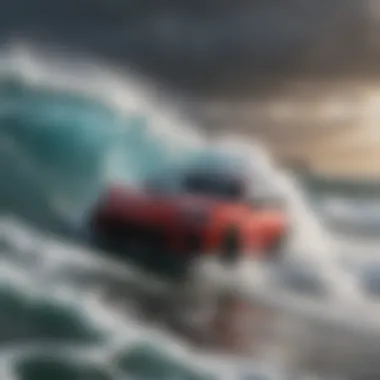
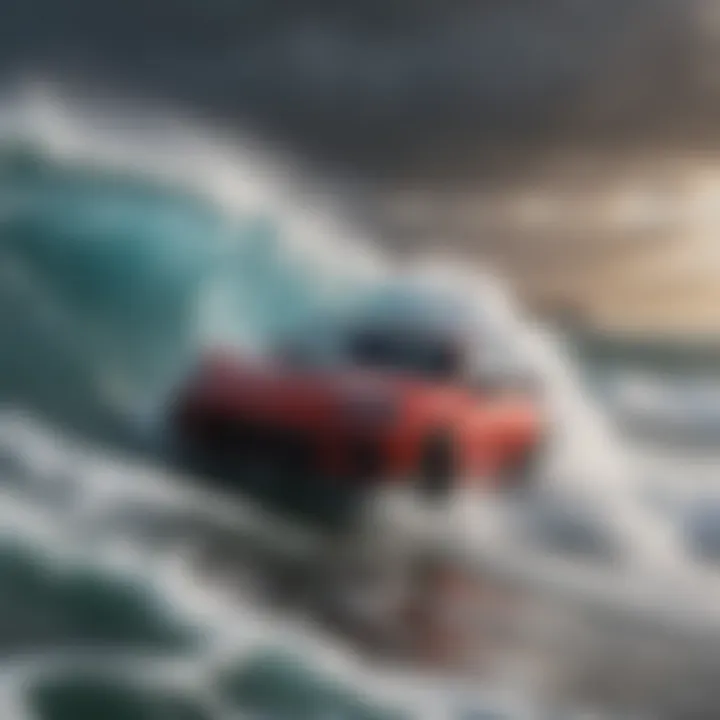
Conservation Implications
The act of capturing wave imagery carries conservation implications that extend beyond the frame. Educational opportunities arise when photographers share their work, potentially raising awareness about ocean conservation. Their images can evoke emotional responses, inspiring action to protect marine environments. Furthermore, photographers play a vital role in documenting changes in ocean systems, serving as witnesses to climate change and its effects on waves and shorelines.
Benefits of Conservation-Focused Photography:
- Raising Awareness: Photographers can spotlight environmental issues through their work, influencing public perception and advocacy.
- Supporting Conservation Efforts: Partnering with organizations can lead to initiatives that protect marine environments, with a portion of proceeds from photography sales directed toward conservation.
- Engaging the Community: Organizing local events or workshops can foster a sense of community among like-minded individuals focused on ocean preservation.
In summary, the environmental impact of wave photography encompasses ethical responsibilities and potential conservation benefits. Navigating this landscape effectively can enhance not only the photographer's work but also contribute to the broader mission of protecting our oceans.
Showcasing Large Wave Photography
Showcasing large wave photography goes beyond simply displaying images. It plays a crucial role in the appreciation and understanding of this art form. The way we present these photographs can elevate the viewer's experience, making them more than mere images. When curated well, galleries and exhibitions can create immersive environments that transport visitors to the ocean's edge, revealing the sheer power and beauty of nature.
Galleries and Exhibitions
Galleries and exhibitions are pivotal in capturing the essence of large wave photography. These spaces allow photographers to share their work with a broader audience. Physical exhibitions often create a unique atmosphere where the scale and intricacies of large waves can be fully appreciated.
- Engagement with the Audience: Galleries provide an opportunity for direct interaction between the photographer and viewers. This connection can enhance understanding of the thoughts and emotions behind each image. Visitors can ask questions and gain insights that deepen their appreciation of the works displayed.
- Thematic Presentations: Curators have the ability to arrange photos thematically. For instance, an exhibition focusing on the raw power of waves might feature images that highlight turbulence and force, while another may showcase calm and tranquil scenes. Such thoughtful presentations can draw out the narrative and emotional layers of each piece, making the experience more engaging.
- Educational Opportunities: Exhibitions can also function as educational platforms. Artists often participate in talks or panels that discuss the techniques, challenges, and inspirations behind their work. By incorporating this dimension, galleries foster a richer understanding of wave dynamics and the artistry involved in capturing them.
Online Platforms and Social Media
In today’s digital age, online platforms and social media have transformed how large wave photography is showcased. These tools open up numerous avenues for exposure, reaching audiences far beyond geographical constraints.
- Global Reach: Social media allows photographers to share their work instantaneously with a global audience. Platforms like Instagram and Facebook enable users to reach fans and fellow enthusiasts. Hashtags related to wave photography can enhance visibility, leading to increased engagement.
- Portfolio Building: Many photographers use websites and online galleries to build portfolios. A well-organized website not only displays their best work but also serves as a means to attract potential clients or galleries interested in exhibitions.
- Community Connection: Online platforms foster a sense of community. Photographers can connect with each other through forums or groups. This is especially beneficial for amateur photographers seeking advice or feedback from seasoned professionals.
As we engage with both galleries and online platforms, it is essential to remember the impact that presentation has on the perception of large wave photography.
"The true art of photography lies not just in capturing the image but in how it resonates with the viewer."
In summary, by showcasing large wave photography effectively, we contribute to its appreciation and help cultivate a deeper understanding of the ocean's dynamics and beauty.
The Future of Large Wave Photography
The future of large wave photography holds profound implications not only for the artistic community but also for environmental awareness. As the world faces increasing challenges related to climate change and ocean preservation, the role of photographers becomes more crucial. Their ability to capture the raw power and beauty of the ocean can influence public perception and inspire action toward conservation. With a growing number of enthusiasts becoming involved in this field, understanding the trajectory of large wave photography will enrich their practice and expand their contributions to ocean advocacy.
Technological Innovations
The advancement of technology significantly shapes the future of large wave photography. Innovations in camera equipment, drones, and editing software provide photographers with newly enhanced capabilities. High-performance cameras with improved low-light performance and faster burst rates allow for the capture of fleeting moments in wave dynamics.
Drones have entered the scene, offering aerial perspectives that were once unattainable. They can access areas that are not safe or feasible for human photographers, expanding the horizons of creativity. Photographers now blend these technologies into their workflows, enabling them to experiment with angles and compositions that showcase the grandeur of waves in uniquely vivid ways.
Moreover, software developments in editing, such as Adobe Lightroom and Photoshop, provide powerful tools to fine-tune images, highlighting colors and textures that convey the exhilarating nature of waves. The continuous integration of artificial intelligence in editing is also assisting photographers in achieving desired artistic effects with greater efficiency and precision.
The potential for virtual reality experiences is another exciting trend. As the medium develops, audiences may begin to experience large wave photography in immersive formats, bringing them closer to the ocean's magnificence than ever before.
Evolving Perspectives on Ocean Conservation
As large wave photography continues to evolve, so do the perspectives on ocean conservation within the field. There is an emerging understanding that photographers have a responsibility not just to capture beauty but to shed light on the environmental challenges facing marine ecosystems. Many are now focusing on documenting the impacts of pollution, rising water temperatures, and climate change on oceans and waves.
This shift in perspective resonates with both photographers and their audiences. A compelling image can serve as a catalyst for discussion and awareness about conservation efforts, urging individuals to take action in their own lives. The shared stories featuring the ocean's strength and vulnerability speak to a broader narrative about humanity's relationship with nature.
Photographers are increasingly collaborating with environmental organizations to amplify their impact. They utilize their work to convey messages that advocate for responsible behavior in coastal areas and support policies aimed at marine protection.
Photography is not just about capturing images; it’s about making a statement and igniting a movement towards environmental stewardship.
In summary, the future of large wave photography not only focuses on artistic innovation but also reflects a deeper commitment to preserving our oceans. Photographers are poised to play a vital role in shaping societal attitudes towards marine conservation, making their contributions ever more significant as we confront environmental challenges.
End
The conclusion of this article brings together the various facets of large wave photography, highlighting its technical intricacies, sensory aesthetics, and crucial environmental considerations. This section underscores the importance of understanding how these elements work in tandem to not only captivate audiences but also to foster a deeper appreciation for the ocean and its dynamics.
Recap of Essential Insights
Throughout this article, we examined the breathtaking world of large wave photography. The discussion began with the foundation of the art form, merging artistic expression and scientific understanding. We explored how the science of waves informs the aesthetic choices photographers make. The equipment section emphasized the necessity of having the right tools, including robust cameras and stabilization gear, essential to capturing striking images even in harsh conditions.
The techniques involved were broken down into shutter speed and composition strategies, showcasing how both aspects are critical in producing visually compelling photographs. Furthermore, we discussed the challenges photographers face, such as unpredictable weather and potential safety risks, providing insight into the mental and physical resilience required in extreme conditions.
The narrative aspect of wave imagery was scrutinized, revealing how emotion and storytelling play vital roles in engaging viewers. We also touched upon the ethical dimensions connected to large wave photography, emphasizing environmental responsibility. This recap solidifies that large wave photography is much more than just capturing images; it is about conveying an experience that connects viewers to nature.
Final Thoughts on the Role of Photographers
Photographers in this genre not only document the raw beauty of the ocean but also serve as its advocates. Their work holds the potential to influence public perception regarding ocean preservation and highlights the fragility of marine ecosystems. With every image, they invite viewers into a shared space of awe and contemplation.
By honing their skills and understanding the responsibility that comes with this craft, photographers become voices for the waves. They can bridge the gap between visual artistry and environmental consciousness, making contributions beyond aesthetics. Their role is crucial in stimulating discussions and prompting action regarding ocean conservation.







